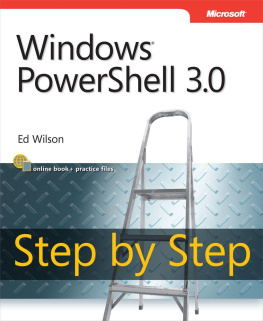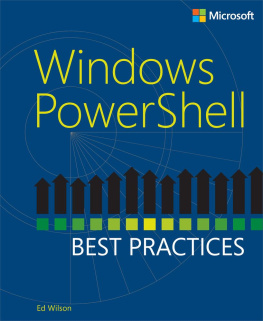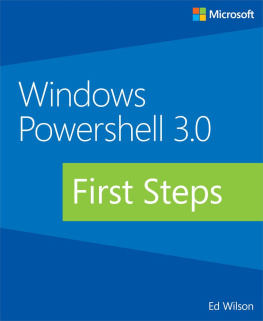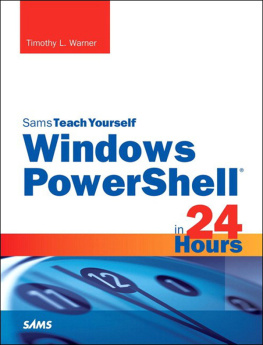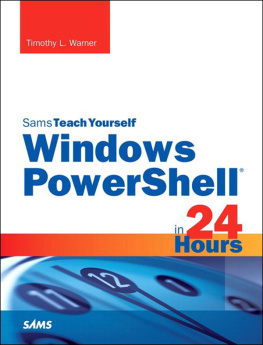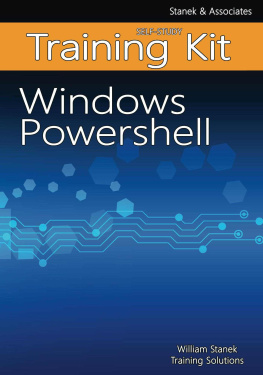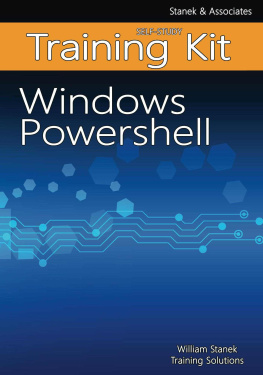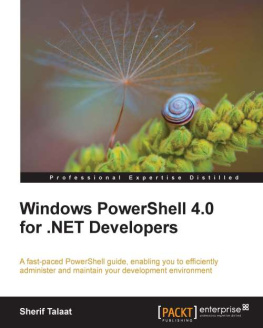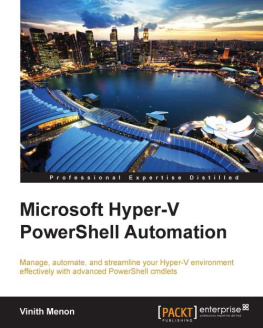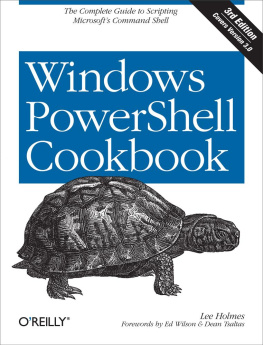If you purchased this ebook directly from oreilly.com, you have the following benefits:
If you purchased this ebook from another retailer, you can upgrade your ebook to take advantage of all these benefits for just $4.99. to access your ebook upgrade.
Foreword
Ive always known that automation was a critical IT Pro skill. Automation dramatically increases both productivity and quality of IT operations; it is a transformational skill that improves both the companies and the careers of the individuals that master it. Improving IT Pro automation was my top priority when I joined Microsoft in 1999 as the Architect for management products and technologies. That led to inventing Windows PowerShell and the long hard road to making it a centerpiece of the Microsoft management story. Along the way, the industry made some dramatic shifts. These shifts make it even more critical for IT Pros to become experts of automation.
During the development of PowerShell V1, the team developed a very strong partnership with Exchange. We thought Exchange would drive industry adoption of PowerShell. You can imagine our surprise (and delight) when we discovered that the most active PowerShell V1 community was VMWare customers. I reached out to the VMWare team to find out why it was so successful with their customers. They explained to me that their customers were IT Pros that were barely keeping up with the servers they had. When they adopted virtualization, they suddenly had 5-10 times the number of servers so it was either automate or drown. Their hair was on fire and PowerShell was a bucket of water.
The move to the cloud is another shift that increases the importance of automation. The entire DevOps movement is all about making change safe through changes in culture and automation. When you run cloud scale applications, you cant afford to have it all depend upon a smart guy with a cup of coffee and a mouseyou need to automate operations with scripts and workflows. When you read the failure reports of the biggest cloud outages, you see that the root cause is often manual configuration. When you have automation and an error occurs, you review the scripts and modify them to it doesnt happen again. With automation, Nietzsche was right: that which does not kill you strengthens you. It is no surprise that Azure has supported PowerShell for some time, but I was delighted to see that Amazon just released 587 cmdlets to manage AWS.
Learning automation with PowerShell is a critical IT Pro skill and there are few people better qualified to help you do that than Ed Wilson. Ed Wilson is the husband of The Scripting Wife and the man behind the wildly popular blog The Scripting Guy. It is no exaggeration to say that Ed and his wife Teresa are two of the most active people in the PowerShell community. Ed is known for his practical how to approach to PowerShell. Having worked with so many customers and people learning PowerShell, Ed knows what questions you are going to have even before you have them and has taken the time to lay it all out for you in his new book: Windows PowerShell 3.0 Step by Step.
Jeffrey Snover, Distinguished Engineer and Lead Architect, Microsoft Windows
Introduction
Windows PowerShell 3.0 is an essential management and automation tool that brings the simplicity of the command line to next generation operating systems. Included in Windows 8 and Windows Server 2012, and portable to Windows 7 and Windows Server 2008 R2, Windows PowerShell 3.0 offers unprecedented power and flexibility to everyone from power users to enterprise network administrators and architects.
Who should read this book
This book exists to help IT Pros come up to speed quickly on the exciting Windows PowerShell 3.0 technology. Windows PowerShell 3.0 Step by Step is specifically aimed at several audiences, including:
Windows networking consultants . Anyone desiring to standardize and to automate the installation and configuration of dot-net networking components.
Windows network administrators . Anyone desiring to automate the day-to-day management of Windows dot-net networks.
Microsoft Certified Solutions Experts (MCSEs) and Microsoft Certified Trainers (MCTs) . Windows PowerShell is a key component of many Microsoft courses and certification exams.
General technical staff . Anyone desiring to collect information, configure settings on Windows machines.
Power users . Anyone wishing to obtain maximum power and configurability of their Windows machines either at home or in an unmanaged desktop workplace environment.
Assumptions
This book expects that you are familiar with the Windows operating system, and therefore basic networking terms are not explained in detail. The book does not expect you to have any background in programming, development, or scripting. All elements related to these topics, as they arise, are fully explained.
Who should not read this book
Not every book is aimed at every possible audience. This is not a Windows PowerShell 3.0 reference book, and therefore extremely deep, esoteric topics are not covered. While some advanced topics are covered, in general the discussion starts with beginner topics and proceeds through an intermediate depth. If you have never seen a computer, nor have any idea what a keyboard or a mouse are, then this book definitely is not for you.
Organization of this book
This book is divided into three sections, each of which focuses on a different aspect or technology within the Windows PowerShell world. The first section provides a quick overview of Windows PowerShell and its fundamental role in Windows Management. It then delves into the details of Windows PowerShell remoting. The second section covers the basics of Windows PowerShell scripting. The last portion of the book covers different management technology and discusses specific applications such as Active Directory and Exchange.
Finding your best starting point in this book
The different sections of Windows PowerShell 3.0 Step by Step cover a wide range of technologies associated with the data library. Depending on your needs and your existing understanding of Microsoft data tools, you may wish to focus on specific areas of the book. Use the following table to determine how best to proceed through the book.
If you are | Follow these steps |
|---|
New to Windows PowerShell | Focus on , or read through the entire book in order. |
An IT pro who knows the basics of Windows PowerShell and only needs to learn how to manage network resources | Briefly skim if you need a refresher on the core concepts. Read up on the new technologies in . |

